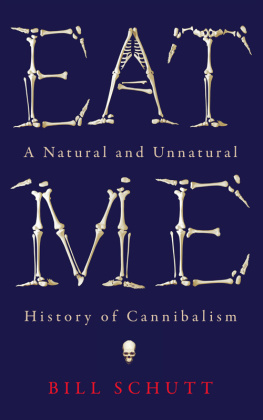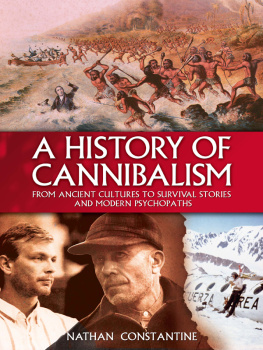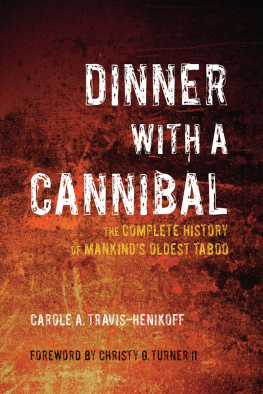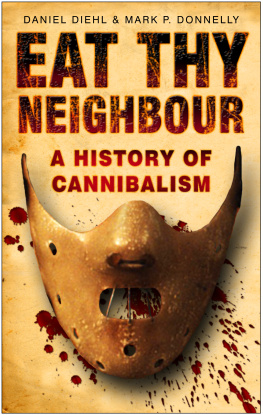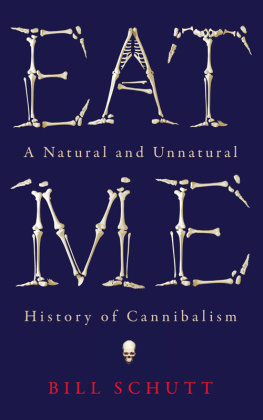EAT
A Natural and Unnatural
ME
History of Cannibalism
BILL SCHUTT is Professor of Biology at LIU-Post (Long Island University) and Research Associate at the American Museum of Natural History. He is the author of Dark Banquet: Blood and the Curious Lives of Blood-Feeding Creatures and a novel, Hells Gate (with J. R. Finch).
EAT
A Natural and Unnatural
ME
History of Cannibalism
BILL SCHUTT

First published in Great Britain in 2017 by
PROFILE BOOKS LTD
3 Holford Yard
Bevin Way
London
WC1X 9HD
www.profilebooks.com

Published in association with Wellcome Collection
Wellcome Collection
183 Euston Road
London NW1 2BE
www.wellcomecollection.org
Copyright Bill Schutt, 2017
The moral right of the author has been asserted.
All rights reserved. Without limiting the rights under copyright reserved above, no part of this publication may be reproduced, stored or introduced into a retrieval system, or transmitted, in any form or by any means (electronic, mechanical, photocopying, recording or otherwise), without the prior written permission of both the copyright owner and the publisher of this book.
A CIP catalogue record for this book is available from the British Library.
eISBN 978 1 78283 130 3
For Janet and Billy Schutt
And for my best friend, Robert A. Adamo (19532011)
PROLOGUE
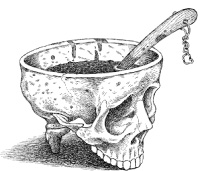
A census taker tried to quantify me once. I ate his liver with some fava beans and a big Amarone.
Hannibal Lecter in Thomas Harris, The Silence of the Lambs
TO MARK ITS ONE-HUNDRED-year anniversary in 2003, the American Film Institute polled its members to determine the fifty greatest screen villains of all time. Topping the AFI list was the ultimate in fictionalised cannibals, Dr Hannibal Lecter, while second place went to Norman Bates, the mother-fixated hotel manager of Alfred Hitchcocks 1960 classic Psycho.
While Batess link to man-eating may not be immediately clear, it turns out that he too had his roots in the cannibal tradition. From the films opening scene, Hitchcock invited audiences to confront some long-held taboos. Filmgoers titillated the previous year by the first of the Rock Hudson/Doris Day bedroom comedies suddenly found themselves transformed into voyeurs, peering into shadowy corners previously unseen by mainstream movie audiences. Psycho soon became a sensation with the public and remains so today. More than a half-century after its release, Bernard Herrmanns strings-only score is perhaps the most instantly recognisable music ever written for a film. Less well known was the fact that Joseph Stefanos screenplay for Psycho had been adapted from a Robert Bloch pulp novel about Wisconsin native Edward Gein (pronounced Geen), a real-life murderer, grave robber, necrophile and cannibal.
Born in 1906, Gein lived a solitary and repressed life under the thumb of a domineering mother. The family owned a 160-acre farm, seven miles outside the town of Plainfield, but when his brother died in 1944 Gein abandoned all efforts to cultivate the land. Instead, he relied on government aid and the occasional odd job to support himself and his mother. When she died in 1945, Gein found himself alone in the large farmhouse. He sealed off much of it and left his mothers room exactly as it looked when she was alive. The house itself fell into such serious disrepair that the neighbourhood kids began claiming that it was haunted.
On the night of 17 November 1957, things began to unravel for the recluse known as Weird Old Eddie. The police were investigating the disappearance of local shopkeeper Bernice Worden when they got a tip that Gein had been seen in her hardware store several times that week. They picked him up at a neighbours house, where he was having dinner, and questioned him about the missing woman. She isnt missing, Gein told them, shes down at the house now.
Geins dilapidated farmhouse had no electricity, so the cops used torches and oil lamps to pick their way through the debris-strewn rooms. In a shed in the back yard, one of the men bumped into what he assumed to be the remains of a dressed-out deer hanging from a wooden beam. But the fresh carcass hanging upside down was no deer; it was the decapitated body of Mrs Worden. As the stunned lawmen moved through the gruesome crime scene it became clear that the neighbourhood kids had been right. The Gein house was haunted. Each room they entered presented a new nightmare: soup bowls made from human skulls, a pair of lips attached to a window shade drawstring, a belt made from human nipples. In the kitchen, the police reportedly found Bernice Wordens heart sitting in a frying pan on the stove and an icebox stocked with human organs.
Soon after Geins arrest, media correspondents from all over the world began descending on the town and its shocked populace. Reporters poked around the Gein farm and interviewed neighbours. Some of the locals recounted how theyd been given venison by Gein, who later told authorities that he had never shot a deer in his life. Perhaps surprisingly, the Plainfield Butcher had also been a popular babysitter.
With the publication of a seven-page article in Life magazine (and a two-page spread in Time), millions of Americans became fascinated with Ed Gein and his crimes. Plainfield became a tourist attraction with bumper-to-bumper traffic crawling through the narrow streets.
The following year, Robert Bloch drew on the Gein crimes in his novel, relocating his tale to Phoenix and concentrating on the mother fixation while playing down the mutilation and cannibalism. An assistant gave Alfred Hitchcock the book and he procured the film rights soon after reading it. The director also had his staff buy up as many copies of the novel as they could find. He wanted to prevent readers from learning about the plot and revealing its secrets. After some initial resistance from Paramount Pictures, the Master of Suspense directed his most famous and financially successful film one that would never have been made if not for Ed Gein, a quiet little cannibal who explained to the authorities, I had a compulsion to do it.
Perhaps it shouldnt come as a surprise, though, that our greatest cinematic villain is a man-eating psychiatrist while the mild-mannered runner-up is based on a real-life cannibal-killer. Particularly if we consider that many cultures share the belief that consuming another human is the most heinous act a person can commit. As a result, real-life cannibalistic psychopaths like Jeffrey Dahmer (another Wisconsin native) and his Russian counterpart Andrei Chikatilo have attained something akin to mythical status in the annals of historys most notorious murderers. These tales feed our obsession with all things gruesome an obsession that is now an acceptable facet of our society.
Psychopaths aside, perhaps those most commonly associated with the word cannibal are the so-called primitive social or ethnic groups who historically have engaged in ritual man-eating. In colonial times, these savages were at best pegged as souls to be saved, but only if they repented. If they failed to do so, they were brutalised, enslaved and murdered. The most infamous period of such ill treatment began during the last years of the fifteenth century when millions of people indigenous to the Caribbean and Mexico were summarily reclassified as cannibals for reasons that had little to do with people-eating. Instead, it paved the way for them to be robbed, beaten, conquered and slain, all at the whim of their new Spanish masters.
Next page
